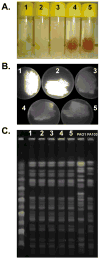Secretion of Pseudomonas aeruginosa type III cytotoxins is dependent on pseudomonas quinolone signal concentration
- PMID: 20570614
- PMCID: PMC2935322
- DOI: 10.1016/j.micpath.2010.05.013
Secretion of Pseudomonas aeruginosa type III cytotoxins is dependent on pseudomonas quinolone signal concentration
Abstract
Pseudomonas aeruginosa is an opportunistic pathogen that can, like other bacterial species, exist in antimicrobial resistant sessile biofilms and as free-swimming, planktonic cells. Specific virulence factors are typically associated with each lifestyle and several two component response regulators have been shown to reciprocally regulate transition between biofilm-associated chronic, and free-swimming acute infections. Quorum sensing (QS) signal molecules belonging to the las and rhl systems are known to regulate virulence gene expression by P. aeruginosa. However the impact of a recently described family of novel quorum sensing signals produced by the Pseudomonas Quinolone Signal (PQS) biosynthetic pathway, on the transition between these modes of infection is less clear. Using clonal isolates from a patient developing ventilator-associated pneumonia, we demonstrated that clinical observations were mirrored by an in vitro temporal shift in isolate phenotype from a non-secreting, to a Type III cytotoxin secreting (TTSS) phenotype and further, that this phenotypic change was PQS-dependent. While intracellular type III cytotoxin levels were unaffected by PQS concentration, cytotoxin secretion was dependent on this signal molecule. Elevated PQS concentrations were associated with inhibition of cytotoxin secretion coincident with expression of virulence factors such as elastase and pyoverdin. In contrast, low concentrations or the inability to biosynthesize PQS resulted in a reversal of this phenotype. These data suggest that expression of specific P. aeruginosa virulence factors appears to be reciprocally regulated and that an additional level of PQS-dependent post-translational control, specifically governing type III cytotoxin secretion, exists in this species.
Copyright 2010 Elsevier Ltd. All rights reserved.
Figures




Similar articles
-
Pseudomonas quinolone signalling system: a component of quorum sensing cascade is a crucial player in the acute urinary tract infection caused by Pseudomonas aeruginosa.Int J Med Microbiol. 2014 Nov;304(8):1199-208. doi: 10.1016/j.ijmm.2014.08.013. Epub 2014 Sep 1. Int J Med Microbiol. 2014. PMID: 25240873
-
Pseudomonas Quinolone Signal-Induced Outer Membrane Vesicles Enhance Biofilm Dispersion in Pseudomonas aeruginosa.mSphere. 2020 Nov 25;5(6):e01109-20. doi: 10.1128/mSphere.01109-20. mSphere. 2020. PMID: 33239369 Free PMC article.
-
The Pseudomonas quinolone signal regulates rhl quorum sensing in Pseudomonas aeruginosa.J Bacteriol. 2000 May;182(10):2702-8. doi: 10.1128/JB.182.10.2702-2708.2000. J Bacteriol. 2000. PMID: 10781536 Free PMC article.
-
Relationship between Pyochelin and Pseudomonas Quinolone Signal in Pseudomonas aeruginosa: A Direction for Future Research.Int J Mol Sci. 2024 Aug 7;25(16):8611. doi: 10.3390/ijms25168611. Int J Mol Sci. 2024. PMID: 39201297 Free PMC article. Review.
-
Quorum sensing by 2-alkyl-4-quinolones in Pseudomonas aeruginosa and other bacterial species.Mol Biosyst. 2008 Sep;4(9):882-8. doi: 10.1039/b803796p. Epub 2008 Jun 30. Mol Biosyst. 2008. PMID: 18704225 Review.
Cited by
-
Azithromycin to prevent Pseudomonas aeruginosa ventilator-associated pneumonia by inhibition of quorum sensing: a randomized controlled trial.Intensive Care Med. 2012 Jul;38(7):1118-25. doi: 10.1007/s00134-012-2559-3. Epub 2012 Apr 20. Intensive Care Med. 2012. PMID: 22527075 Clinical Trial.
-
Multiple phenotypic changes associated with large-scale horizontal gene transfer.PLoS One. 2014 Jul 21;9(7):e102170. doi: 10.1371/journal.pone.0102170. eCollection 2014. PLoS One. 2014. PMID: 25048697 Free PMC article.
-
Impact of ureido/carboxypenicillin resistance on the prognosis of ventilator-associated pneumonia due to Pseudomonas aeruginosa.Crit Care. 2011;15(2):R112. doi: 10.1186/cc10136. Epub 2011 Apr 11. Crit Care. 2011. PMID: 21481266 Free PMC article.
-
Intrinsic and Extrinsic Regulation of Type III Secretion Gene Expression in Pseudomonas Aeruginosa.Front Microbiol. 2011 Apr 25;2:89. doi: 10.3389/fmicb.2011.00089. eCollection 2011. Front Microbiol. 2011. PMID: 21833328 Free PMC article.
-
The global regulator Crc plays a multifaceted role in modulation of type III secretion system in Pseudomonas aeruginosa.Microbiologyopen. 2013 Feb;2(1):161-72. doi: 10.1002/mbo3.54. Epub 2013 Jan 4. Microbiologyopen. 2013. PMID: 23292701 Free PMC article.
References
-
- Attila C, Ueda A, Wood TK. PA2663 (PpyR) increases biofilm formation in Pseudomonas aeruginosa PAO1 through the psl operon and stimulates virulence and quorum-sensing phenotypes. Appl Microbiol Biotechnol. 2008;78:293–307. - PubMed
-
- Bassler BL. How bacteria talk to each other: regulation of gene expression by quorum sensing. Curr Opin Microbiol. 1999;2:582–7. - PubMed
-
- Bjarnsholt T, Jensen PO, Burmolle M, Hentzer M, Haagensen JA, Hougen HP, Calum H, Madsen KG, Moser C, Molin S, Hoiby N, Givskov M. Pseudomonas aeruginosa tolerance to tobramycin, hydrogen peroxide and polymorphonuclear leukocytes is quorum-sensing dependent. Microbiology. 2005;151:373–83. - PubMed
-
- Bjarnsholt T, Jensen PO, Fiandaca MJ, Pedersen J, Hansen CR, Andersen CB, Pressler T, Givskov M, Hoiby N. Pseudomonas aeruginosa biofilms in the respiratory tract of cystic fibrosis patients. Pediatr Pulmonol. 2009;44:547–58. - PubMed
Publication types
MeSH terms
Substances
Grants and funding
LinkOut - more resources
Full Text Sources

